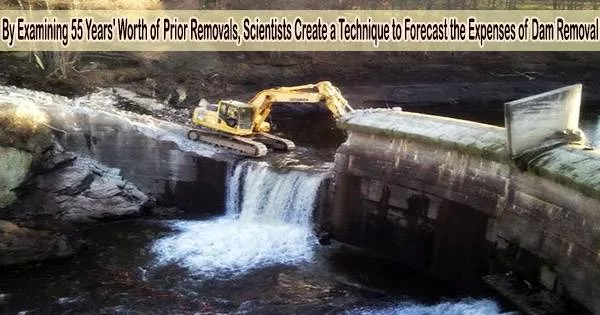In order to create a technology that can more accurately predict the price of future dam removals, scientists have examined more than 650 dam removal projects that have taken place in the US over the course of 55 years and cost $1.52 billion inflation-adjusted.
The analysis comes at a time when thousands of dams are being destroyed because they are old, unsafe, no longer performing their original function, or require expensive repairs and maintenance, as well as a time when people are becoming more conscious of the disruptive effects dams may have on ecosystems.
“We are transitioning from a period of building dams to one that includes removing dams,” said Jeffrey Duda, a research ecologist with U.S. Geological Survey’s Western Fisheries Research Center. “But estimating costs of removing dams is a challenge, which makes it difficult to weigh when dam removal may be a viable alternative.”
Duda and scientists from the USGS, Oregon State University, the Bureau of Reclamation, U.S. Army Corps of Engineers, and the University of Georgia, begin to unravel those challenges in a paper just published in Frontiers in Ecology and Evolution.
“The results help us get beyond the common perception of ‘every dam removal is different,’” said Desiree Tullos, a water resources engineer at Oregon State. “That’s still true, but these databases give us a sense of the common and divergent features of dam removals across the U.S.”
“When working through detailed costs with practitioners, we found that height isn’t always the best predictor of cost. Other factors like site restoration, mitigation of potential negative impacts of dam removal and sediment management can be major cost drivers, and those are often dependent on the preferences of local regulators and interested parties.”
We are transitioning from a period of building dams to one that includes removing dams. But estimating costs of removing dams is a challenge, which makes it difficult to weigh when dam removal may be a viable alternative.
Jeffrey Duda
Over the past 50 years, there has been a marked increase in the number of dams demolished in the United States. According to earlier study by Duda, Tullos, and others, the number of dams demolished grew from 45 to 139 to 313 to 637 across four 10-year periods beginning in 1976 and ending in 2015.
Now, as part of the 2022 Bipartisan Infrastructure Law, the federal government is awarding $733 million for dam safety projects, including dam removals. A recent estimate predicted that by 2050 between 4,000 and 32,000 more dams will be removed in the United States.
For the new paper, the researchers compiled reported costs for 668 dams removed from 1965 to 2020 in the United States. When adjusted for inflation into 2020 dollars, the projects totaled $1.52 billion dollars.
Less than 5 meters, between 5 and 10 meters, and larger than 10 meters were used to classify the dams that were removed. The median cost respectively for the three categories was $157,000, $823,000 and $6.2 million.
They also analyzed geographic differences in dam removals. The northeast accounted for the most dam removals with 277, followed by the Midwest (222), Southwest (78), Northwest (50) and Southeast (41). More than 80% of the dams were five meters or less.
The Northwest accounted for the highest cost, totaling $775.8 million, more than triple the second-place Midwest. The cost in the Northwest is influenced by several recent large-scale projects on the Elwha and Clark Fork rivers in Washington and Montana.
The researchers also estimated the main cost drivers of dam removal. The greatest predictor was dam height, followed by average river discharge and project complexity, which takes into consideration expenses for construction and sediment management, mitigation for the effects of dam removal, and post-removal outcomes like replacing vegetation in former reservoir surfaces. Additionally major but less crucial influences included regional variations and dam construction.
In order to increase the predicted accuracy of a machine-learning model, the researchers intend to incorporate more data in the upcoming years as new projects and reported expenses become available.
“The model is going to get better and better and further help decision-makers as they grapple with how to manage the large number of dams approaching obsolescence,” Duda said.
Other co-authors of the paper are Suman Jumani, Daniel Wieferich, S. Kyle McKay, Timothy Randle, Alvin Jansen, Susan Bailey, Benjamin L. Jensen, Rachelle Johnson, Ella Wagner, Kyla Richards, Seth Wenger, Eric Walther and Jennifer Bountry.
Tullos is affiliated with Oregon State’s colleges of engineering and agricultural sciences.
















